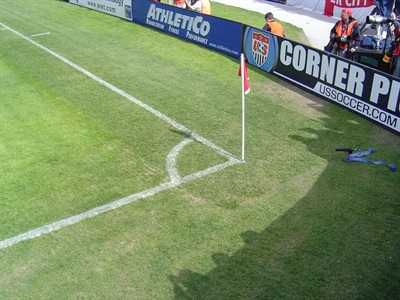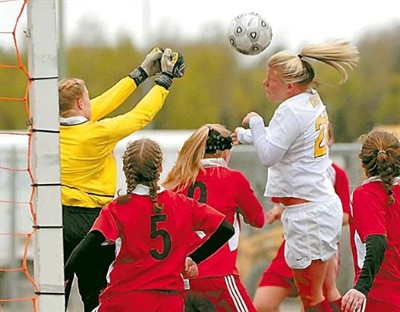|
When the ball goes over the goal line last touched by a member of the defending team, the restart should benefit the attacking team in some small way. The game offers them a free kick from within the corner arc. |

|
IT IS A FREE KICK
Referees must remember that a corner kick, like a penalty kick, is a very specialized free kick. It has its own law in the Laws of the Game but many of the characteristics are the same: the ball must be stationary, the kicker may not play the ball twice in succession, the opponents must be at least 10 yards from the corner arc, etc. Do not allow the opponents within 10 yards of the corner kick, any more than you would allow them to get within 10 yards of a direct free kick.
|
REFEREE POSITIONING
Teams are developing new tactical approaches to taking corner kicks and referees need to stay up-to-date about how to deal effectively with them. The "short corner" is a good example. Appearing in World Cup play for the first time in 1994, referees were at first unsure about the best position each should take and what each should be watching for (an offside violation can more easily occur unobserved in a short corner situation. More recently, a new "trick play" has emerged. A player stands at the arc with the ball like they are going to take the kick. Suddenly, they walk away and invite someone else to take the kick, however, the touch and move the ball as they leave the area. The invited player shows up and dribbles the ball forward and deliver a ball into the penalty area from closer range. Coaches were very proud of this trick and would get upset if the referee did not recognize that a proper corner kick was indeed taken.
Positioning the same place for each corner kick can generate a problem. Skilled and devious players will soon recognize the pattern and capitalize upon your habit to find the area where they can foul to gain an advantage out of your sight. Therefore it is recommended that you vary your positioning occasionally during the match. The lead referee may move behind the kicker or up along the goal line. The trail referee may pull up to the far upper edge of the penalty area or a few yards above the penalty arc.
|
READ PLAY
Look at what teams have been doing earlier in the game to get clues about what they might do. Factor in the score and the time remaining. Realize that substitution patterns may alter what teams attempt to do during corner kicks. Because MLS teams are starting to bring goalkeepers the length of the field during corner kicks, look for teams in your area to start mimicking those tactics.
|

|
GOALKEEPERS
Goalkeepers present a wonderful challenge for referees during corner kicks. The Laws of the Game offer them no special protection. Yet their fans and teammates will cry, protest and demand they be protected. Many referees interpret the spirit of the game to infer that goalkeepers should be given that little edge in a 50-50 contest. Are you one of those? If you are, it deserves some additional thought. It should not be done automatically.
Your stock as a referee and game manager can soar in the eyes of the defenders when you appropriately handle an attacker roughing up a goalkeeper. Watch for someone fronting the keeper and moving their heels continuously. They are trying to "accidentally" step on the keeper's toes with one of two thoughts in mind: get the keeper's mind focused on the painful toes instead of the ball heading goal-ward, or get the keeper to retaliate with a push in full view of the referee.
Goalkeepers also become very aggressive in their endeavor to keep a clean slate. They will go over and through people to punch or collect the ball. Sometimes their aggressiveness is careless or reckless.
You must try to bring a balance to those actions. Your positioning to see all those subtle dramas is a great start. A well-spoken word of warning as soon as the actions start places you in firm control. An authoritative whistle as soon as the actions become careless lets everyone know where the limits are during the later stages of the game. For those few who do not heed your earlier messages, a card may turn out to be your moment of truth when you demonstrate you will act as needed for player's safety.
|
ASSESSORS
Assessors may share information about how they handle corner kicks. Many discussions you have with assessors will increase your knowledge of the game and your awareness of positioning. But there are tales of woe out there as well. There are rumors that assessors are telling referees that is where you must stand at corner kicks. There is no one right location. If an assessor dictates that you take a certain location during a post-game debrief, listen to the comment, say "Thank you very much" after the debrief and then use common sense positioning based on your reading of the play.
|
COMMON SENSE
Let's walk through a typical scenario and see where common sense takes us: A ball last touched by a defensive player (goalkeeper) passes wholly over the goal line directly over the center of the crossbar. In this example, the late afternoon game is tied with six minutes to play.
The referee must decide where the next restart occurs. When faced with that choice, all things being equal, it might not matter which corner is used. However, faced with the setting sun in a tie game, the referee should use law XVIII to decide to have the kick taken from the east corner. That way the goalkeeper does not have to defend while looking into the rays of the sun. That decision is not based on law, but one instance of common sense that makes up much of officiating.
|
 |